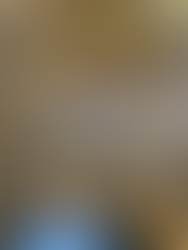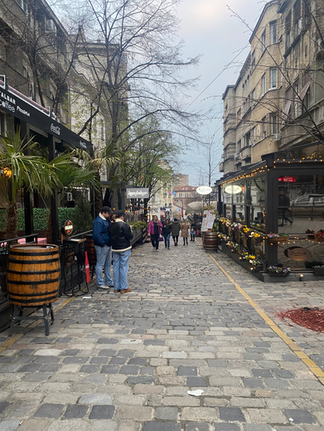One of my favourite times to travel is over Easter weekend, as we get two Bank Holidays (Good Friday and Easter Monday) in the UK, allowing for a 4-day trip without taking any annual leave. Following last year's success with Tunisia, the same friend and I set off for Belgrade, Serbia. You may know that in 2022 I'd visited Kosovo, and that foreign nationals have been denied entry to Serbia for having Republic of Kosovo stamps in their passport; luckily, I have dual citizenship so managed to travel to both countries without any issues.
Good Friday
After the 3:30am wakeup and multiple flights (with a connection in Munich, which we'd recently visited for Oktoberfest), we made it to Belgrade by lunchtime. We'd both managed to sleep on the flights so surprisingly, we weren't very tired, and after settling into our lovely Airbnb, we immediately searched for a restaurant serving local cuisine. I had researched Serbian dishes and was very excited to be reunited with a popular dish in Eastern Europe called 'sarma' (cabbage leaves stuffed with mince), and 'ajvar' (a roasted red pepper sauce) which I'd tried previously in North Macedonia. I was also keen to try 'kajmak', a Serbian cheese with a unique flavour.
With our stomachs full, we decided to explore our local area, which included a fortress (Belgrade Fortress), the main square (Republic Square), and a gorgeous library (Akademija) with ladders to access the books and various editions of the classics (available in English too!). Our immediate observations were that the main streets were very wide and pretty, the language sounded similar to Italian, and that smoking was prolific, including inside restaurants and bars. After enjoying a few drinks, we treated ourselves to some sushi (I am happy to diversify as long as I try local foods as well), before calling it a day.
Holy Saturday
Saturday was one of two full days we had to explore the city, so although our time was limited, we also weren't rushing around to see everything as we only had a handful of landmarks we were determined to see and wanted to take it easy. That said, our main destinations on the Saturday were quite a walk away so we managed to get in our steps.
We started by visiting one (of several) sites depicting the ruins left as a result of NATO bombings during the Kosovo War; although dark tourism is controversial, I believe it can be educational and worthwhile in some situations - read about my thoughts on dark tourism here. We then visited the Church of Saint Sava, one of the largest Eastern Orthodox churches in the world, which was beautiful inside and out. Outside there were many vendors selling crowns for children made from leaves and pompoms, coloured candy floss, and helium balloons - I'm unsure whether this was in anticipation of the Eastern Orthodox Easter (which was the following weekend) or an everyday occurrence, but regardless it was nice to see.
After a traditional bean stew with homemade bread (which was heavy but absolutely delicious and reminded me of a typical Portuguese dish called 'feijoada'), we headed to the Museum of Yugoslavia, which I was very interested in as I'd heard very mixed opinions on communism throughout my travels in Eastern Europe - from a Croatian deeming it great, to a Romanian saying it was a horrible time. The museum was fascinating, my favourite parts being all of the gifts from world leaders to Tito, the President of Yugoslavia, and the mausoleum for Tito in the 'House of Flowers'. Following conversations with locals and research, I understand that although some former states of Yugoslavia preferred to be independent, Serbia was one of the most content states (if not the most) and bought into the idea of Yugoslavia more than others, with people believing that life was better under communism as they had more time to spend with family and were provided with everything that they needed, despite the lack of recognition as an independent country with its own culture and ethnicity. This was fascinating (and unexpected) to me as I was born and raised in the UK so have never known communism and if anything have seen propaganda against it. I would definitely recommend visiting this museum if you are ever in Belgrade!
We then got a bus back to the city centre, where we visited the oldest bookshop in Serbia (but not in the world, which resides in Lisbon), which was nice but there were very few international books and it wasn't as impressive as the one we'd visited the previous day (Akademija). For dinner, we headed to an artsy, bohemian street called Skadarlija, which was filled with authentic restaurants and musicians who'd play at each table and was very enjoyable (but slightly pricier than elsewhere).
Our impressions on the Saturday were that it was a lot more slow paced than anticipated, and although locals don't smile back if you smile at them, they always make an effort and treat us kindly and we never felt unsafe.
Easter Sunday
Easter Sunday provided us with our first glimpse of sunshine since arriving in Belgrade. Within the past week it had gone from 25°C to snowing, and it had been about 10°C and cloudy since we'd arrived, so the sunshine was a very pleasant surprise. We had breakfast opposite the gorgeous 'House of the National Assembly of the Republic of Serbia' (i.e. Parliament), although it's worth noting that café culture is very different to that in Western Europe.
I bought a magnet (a souvenir I buy in every new country I visit and a family tradition) and we explored Belgrade Fortress properly, which is free and offers some lovely views. Nearby is a dinosaur park, a military museum, a shop selling various old maps, and a café/bar in which we enjoyed a nice, cold cider in the sun. We then headed downtown, where we enjoyed lunch on a terrace, before visiting the Museum of Serbia, which was located on the main square. This museum is free on Sundays and is very different to the Museum of Yugoslavia, with a timeline of Serbia's history and relics on the ground floor and artwork on the top two floors. I enjoyed the variety offered at this museum and it was the perfect place to spend the afternoon. We explored the various green spaces in the city and relaxed until dinner, reminiscing on our trip thus far.
Easter Monday
Our final morning in the city was short-lived but worth mentioning as a local taxi driver, Dragan, taught us a lot about the city as he dropped us off at the airport. We learnt that he deemed life to be good during communist times, as the country was much richer and he had time to hike in the mountains, exercise, and eat and drink with his loved ones, whereas now he felt he had no time to enjoy these pastimes as he was often working. We learnt that Serbia's summers are very hot, reaching 42°C, that the Eastern Easter is celebrated very similarly to the Western Easter (namely with lots of chocolate eggs), and that the government were wanting to ban smoking indoors, as in various other countries. Dragon also pointed out Novak Djokovic's restaurant and various buildings owned by wealthy businessman.
In the airport, I had a cute interaction with a stranger as the guy opposite me realised that we were reading the same book and was excited about it (as was I), and despite our (very) short layover of 35 minutes, we had no issues with either flight and arrived in London safe and sound, with the whole evening to spare.
Although Belgrade isn't many people's go-to destination (many of my friend's didn't even know where it was), it is worth visiting for a very relaxing (yet educative) break, especially over a long weekend in the Spring or Summer.





































Comentarios